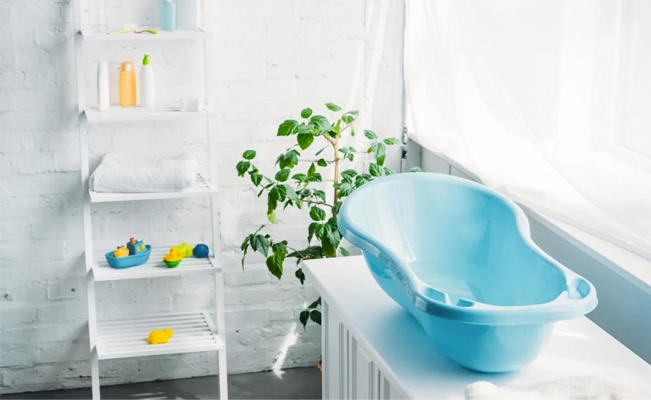If you’re about to welcome your little one into the world, you’ll no doubt be wondering about how to get to grips with the basics, like bath time. This is a precious opportunity to bond with your baby, and introduce them to the soothing sensations of warm water on their skin. So, before taking the plunge, why not take a look at our tips and advice, so you can stay safe, and soak up the fun at bath time.
When should you give your baby their first bath?
There’s no hard and fast rule. Recommendations have changed over recent years, and The World Health Organization (WHO) now advises waiting until at least 24 hours post birth until you bathe your baby1.Bathing a baby too soon after birth can disrupt some vital skin-to-skin contact.
Dry skin can also be a reason to delay the first bath. When your baby is born, you’ll probably notice they’re covered in a waxy white substance called vernix, which acts like a natural moisturiser. The American Academy of Pediatrics recommends leaving this on a newborn baby’s skin for some time, to help prevent dryness2.
Once home, it’s really up to you how often you bath your baby. Babies don’t sweat, and as long as you’re changing their diaper regularly, they will probably only need a bath every few days2.

First regular bath basics2.
When you’re ready to give your baby their first proper bath, these steps should help make everything go as smoothly as possible. It might be wise to limit the first few baths to just a few minutes, as this will be a new experience for your baby, and you might find they’re a little uneasy at first.
1) Choose an appropriate tub for your baby2
If you decide to buy a special tub for your baby, choose one that meets safety standards2. If you haven’t got a specifically designed baby bathtub, then a sink can be adequate, but watch out for any possible risks to your baby’s safety, such as taps or a slippery surface.
2) Keep your baby comfy in and out of the water2
Once you’ve undressed your baby, put them in the water so they don’t get cold. Ensure that you’re supporting their head with one hand, using the other hand to lower their body into the water.
3) Stay hands on2
That means keeping everything you need close by, so you can keep your hands on your baby at all times, to reduce any risk of drowning.
4) Check the temperature3
Fill the baby bath with a couple of inches of warm water, and check the temperature with the inside of your wrist. Always run the cold water tap first, and turn it off last, to avoid scalding yourself or your baby.
5) Choose baby-friendly cleansers
Use only a little soap if needed2, and pick a cleanser or soap that is paediatrician approved, as some products can be drying, or irritate baby’s skin.
6) Use a gentle touch2
Take a cloth or sponge and gently clean your baby’s face and hair, working down the body from head to toe. Try to avoid getting any soap in their eyes – if you do, take a damp clean cloth to gently wipe the eyes.
7) Dry baby off2
Once bath time is over, wrap your baby up in a towel as soon as you lift them out of the water. Gently dry their body, paying special attention to the creases such as the neck and underarm area, where any residual damp can cause skin to become sore.
What if your baby’s umbilical cord has not fallen off?
It might be advisable to only give your baby a sponge bath (cleaning only certain areas, rather than submerging their body in water). Umbilical stumps usually fall off in the first two weeks after birth, but check with your doctor if there are any problems2.
A sponge bath is like a regular bath, except you don't put your baby in the water. Set up your area with a bowl of water, a sponge or cloth and a dry towel. Lay your baby on a flat surface (your changing mat might be good for this), keeping your baby warm and comfy with an extra towel under their body2.
Wash your baby from the top down. Start at the face, and move down to the diaper area, being sure to regularly rinse and wring out the cloth as you go. Focus on cleaning any creases such as the neck and the genital area2.
Remember, at first your baby might be a little unsure about bath time. You can reassure them with your voice, and gently lap water onto their body to help them enjoy the feeling of warmth. Once you become more confident, a bath might fast become an important part of your bedtime routine, helping your baby to relax and get ready for sleep. So take things at your pace, and try to soak up the fun!
Prefer to learn from a step by step demonstration video? Sign up now to Enfamama A+ Club to gain instant access to more pregnancy and parenting videos.



